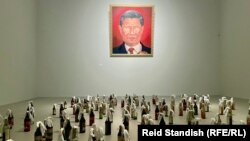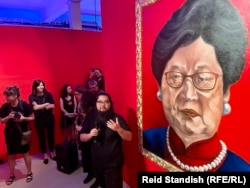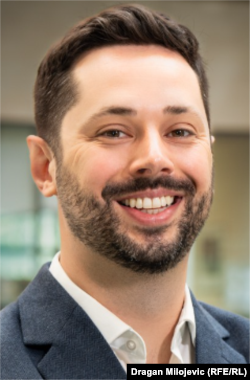PRAGUE -- As Michaela Silpochova, curator at the DOX Center for Contemporary Art in Prague, was putting the final touches on the opening of an exhibit from Chinese dissident artist Badiucao, she received a phone call from a number she didn't recognize.
Speaking in broken Czech on a publicly unavailable number, a woman who identified herself only as "Hong" told Silpochova that hosting Badiucao's art, which was set to premiere the next day on May 12, could damage relations between China and the Czech Republic and that she "hoped the exhibition will not take place."
After repeated requests to identify herself, the woman said she was affiliated with the Chinese Embassy. The unlisted landline the call was made from connects to the embassy's Cultural Department.
"It wasn't exactly a threat, it was more of a warning or something meant to [imply] that there could be some consequences for organizing the show," Silpochova told RFE/RL.
Czech Foreign Minister Jan Lipavsky told the Czech outlet Aktualne on May 13 that he also received a call from the Chinese Embassy in advance of the show saying that it could affect relations between Prague and Beijing.
The embassy did not respond to RFE/RL's request for comment, but Chinese officials have a growing track record of attempting to extend the country's harsh censorship abroad in recent years, with Badiucao's political art becoming an increasingly frequent target.
In November, Chinese officials made unsuccessful requests -- and even threats -- to the hosting gallery in Brescia, Italy, in an attempt to cancel his art show, which contained many provocative works touching on topics that are taboo or even illegal inside China, such as a hybrid portrait of Chinese President Xi Jinping and former Hong Kong Chief Executive Carrie Lam.
Similarly, a guerilla art campaign taking aim at China's hosting of the 2022 Winter Olympics led to controversy at George Washington University in Washington when a student group affiliated with the Chinese Embassy tried to have posters of Badiucao's art removed from campus.
"We knew what happened in Italy in 2021. So, when I heard that someone from the Chinese Embassy was calling, I was not surprised," Silpochova said. "At the same time, we thought that they might have learned their lesson in terms of the negative publicity that doing this [can cause]. [But there are probably procedures] to be followed on their side."
A New Target
The exhibit in Prague is only the second international show for Badiucao, the pseudonym used by the 35-year-old artist who is now based in Australia, and the display builds off his previous work by taking aim at a new target: Russian President Vladimir Putin and his invasion of Ukraine.
Censorship and the authoritarian rule of the Chinese Communist Party have been consistent themes of Badiucao's art, and the Prague exhibit opens with familiar topics such as the brutal Tiananmen Square massacre in 1989, Beijing's internment-camp system in its western Xinjiang Province, the outbreak of COVID-19 in Wuhan, and the compliance of Western companies in enabling Chinese censorship and repression.
But the later part of the show focuses on the Ukraine war and Xi's support for Putin, from providing political cover to creating an international and domestic propaganda effort to boost the Kremlin's skewed narrative of the conflict.
"As a Chinese person, I was very sad to see the Chinese government supporting Putin and supporting his crimes against humanity in Ukraine since the very beginning," Badiucao told RFE/RL.
Among some notable pieces commenting on the ongoing war are a painting titled Little Man's Rage that features Putin exposing himself in a trench coat with a nuclear warhead in place of his genitals and another artwork that features a nurturing Xi breastfeeding an infant Putin.
"This is what I wanted to highlight: Not only the bravery of the Ukrainian people, but also the very fact that Xi Jinping is nursing Putin and giving him a lifeline to continue this war," Badiucao said.
Badiucao used to only appear with his art wearing a mask, fearful of the risks and blowback from Chinese authorities to him and his family, but he revealed his face in 2019 and has since taken on a more public role as both an artist and an activist.
A major theme of the show in Prague is dictators and subverting their authority in unexpected ways. The exhibit concludes with a massive portrait that blends the faces of Xi and Putin into one with the floor in front of the painting littered with Molotov cocktails in soy-sauce bottles.
Baiducao says he wanted to give a nod to what has become a tool of protesters and resistance in Ukraine and in Hong Kong during 2019 protests, showing not only the commonalities between their authoritarian systems but also the people power that continues to push back.
"There will be a victory in the end, but it will be from the hands of ordinary people," he said.




